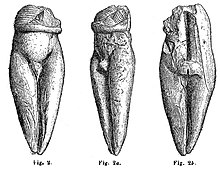At over 25,000 years old, the figurine is the oldest known realistic depiction of a human face.
Wikipedia
| Venus de Brassempouy | |
|---|---|
 | |
| Created | ~25,000 years ago |
| Discovered | 1892 Brassempouy, France |
The Venus of Brassempouy (French: la Dame de Brassempouy, meaning "Lady of Brassempouy", or Dame à la Capuche, "Lady with the Hood") is a fragmentary ivoryfigurine from the Upper Palaeolithic. It was discovered in a cave at Brassempouy, France in 1892. About 25,000 years old, it is one of the earliest known realistic representations of a human face.
Contents
Discovery[edit]
Brassempouy is a small village in the département of Landes in southwest France. Two caves near the village, 100 metres from each other, were among the first Paleolithic sites to be explored in France. They are known as the Galerie des Hyènes (Gallery of the Hyenas) and the Grotte du Pape (the "Pope's Cave"). The Venus of Brassempouy was discovered in the Pope's Cave in 1894,[1] accompanied by at least eight other human figures. These may be an example of unfinished work, as if the artist or artists carved several figurines at the same time.
P. E. Dubalen first explored the Grotte du Pape in 1881, followed by J. de Laporterie and Édouard Piette (1827–1906) from 1894 onwards. Since archaeological excavation techniques were then only starting to develop, they paid little attention to the stratigraphy of the site containing the remains. In 1892 the site was pillaged and disturbed almost beyond reconstruction by a field trip of amateurs from the Association française pour l’avancement de la science.[2] Nevertheless, Piette described layers attributed to the late and middle Solutrean. He termed the bottom levels he reached as éburnéen (pale or white like ivory), in reference to the copious amounts of ivoryworks which they contained. Modern reanalysis of the site has been undertaken under the direction of Henri Delporte, 1981–2000.
In 1894, one of those strata, today recognized as Gravettian, yielded several fragments of statuettes, including the "Lady with the Hood". Piette saw the figures as closely related to the representations of animals of the Magdalenian. He developed a hypothetical chronologythat was later refuted by Henri Breuil.
Description[edit]
The Venus of Brassempouy was carved from mammoth ivory. According to archaeologist Paul Bahn the head is "unsexed, although it is usually called a 'Venus' or a 'lady'".[4] The head is 3.65 cm high, 2.2 cm deep and 1.9 cm wide. The face is triangular and seems tranquil. While forehead, nose and brows are carved in relief, the mouth is absent. A vertical crack on the right side of the face is linked to the internal structure of the ivory. On the head is a checkerboard-like pattern formed by two series of shallow incisions at right angles to each other; it has been interpreted as a wig, a hood with geometric decoration,[5] or simply a representation of hair.
Randall White observed in the Journal of Archaeological Method and Theory (December 2006), "The figurines emerged from the ground into a colonial intellectual and socio-political context nearly obsessed with matters of race."[6] Although the style of representation is essentially realistic, the proportions of the head do not correspond exactly to any known human population of the present or past. Since the mid-twentieth century, interpretative questions have shifted from race to matters concerning womanhood and fertility, White has noted.[6]
Date[edit]
Although the head was discovered so early that its context could not be studied thoroughly, scholars agree that the Venus of Brassempouy belonged to an Upper Palaeolithic material culture, the Gravettian (29,000–22,000 BP). More precisely, they place the figurine in the Middle Gravettian, with "Noailles" burins circa 26,000 to 24,000 BP.[7] It is more or less contemporary with the other Palaeolithic Venus figurines, such as those of Lespugue, Dolní Věstonice, Willendorf, etc. Nonetheless, it is distinguished among the group by the realistic character of the representation.
Display[edit]
The Venus of Brassempouy is preserved in the Musée d'Archéologie Nationale at Saint-Germain-en-Laye, near Paris[8] Since ivory is very susceptible to damage from factors such as temperature change, moisture, and light, the figure is not part of the Palaeolithic's department, but it is exhibited in the Salle Piette of the Museum, only opened with reservation.
At Brassempouy, a variety of objects excavated in the Grotte du Pape are on display at the Maison de la Dame. This exhibition space, primarily devoted to regional archaeology, also displays a fine set of casts of palaeolithic sculptures. These include the nine existing specimens from Brassempouy, but also casts of the well-known figures from Lespugue, Willendorf and Dolní Věstonice, as well as the Mal'ta Venuses, and the Grimaldi Venuses.
Stamp[edit]
In 1976, the Venus of Brassempouy was depicted on a 2.00 franc stamp. It has also been the motif of a 15-franc (CFA) stamp of the Republic of Mali.



沒有留言:
張貼留言